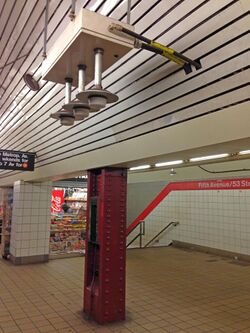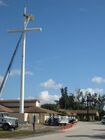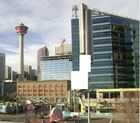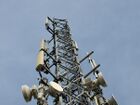Organization:PCIA - The Wireless Infrastructure Association
| Wireless Infrastructure Association (WIA) | |
|---|---|
| WIA is the national trade association that represents the companies, equipment and technologies enabling next-generation wireless. | |
| Overview | |
| Type | Trade association |
| Industry | Wireless infrastructure |
| Formation | 1949 |
| Headquarters | Alexandria, Virginia |
| People | |
| Chairman | Steven Marshall |
| President and CEO | Jonathan Adelstein |
| Executive Vice President | Tim House |
| HetNet Forum Director | Tracy Ford |
| Director, Government Affairs | D. Zachary Champ |
| Director of Meetings and Events | Nancy Touhill |
| Resources | |
| Official Website 2019 Connectivity Expo HetNet Forum | |
The Wireless Infrastructure Association (WIA, formerly known as PCIA) is an American trade association for wireless providers and companies that build cell phone towers, rooftop wireless sites,[1] and other facilities that transmit wireless communication signals. The Washington Post described the industry as "the people who build all those cell towers so you can actually make those calls, download that data."[2] These technologies are collectively referred to as "wireless telecommunications infrastructure."[3][4][5]
Examples of companies that are members of WIA include American Tower, Boingo Wireless, Graybar, SOLiD, and Advanced RF Technologies.[6][7] In all, member companies own and run more than 125,000 towers and antennas in the U.S.[8]
WIA advocates for a variety of issues before the federal government, on topics such as broadband deployment (the act of building wireless broadband infrastructure in the United States), utility pole attachment (adding wireless signal components to utility poles that already exist), wireless network resiliency, public safety, and wireless competition.[9] Every year, WIA hosts a trade show called the Wireless Infrastructure Show.[10]
People
The Chairman of WIA is Steven Marshall, president of the U.S. tower division of American Tower, a leading independent owner, operator and developer of wireless and broadcast communications real estate with a global portfolio of approximately 170,000 sites.[11]
Jonathan Adelstein, a former FCC commissioner, is the President and CEO of WIA.[12] Adelstein worked in public service for 25 years before joining WIA.[3] In February 2014, Adelstein told C-SPAN that his goal was to bring wireless connectivity to everyone in the United States.[lower-alpha 1][14] Tim House is WIA's Executive Vice President. Before WIA, House worked in consumer product marketing at Discovery Communications.[15]
History
1949
Founding
- WIA was founded in 1949. The focus of the group has shifted as technologies have advanced. At various times throughout WIA's history, it has focused on land mobile radio, paging, messaging, personal communications services, and tower and antenna siting.[16]
2012
Supreme Court
- In 2012, WIA submitted an amicus curiae brief in the U.S. Supreme Court case Arlington v. FCC. WIA argued in support of the FCC in the case, arguing that local delays in approval of broadband projects are a national problem. The amicus curiae brief cited evidence that over 3,300 wireless service facility siting applications were pending before local jurisdictions throughout the country, and that around 180 of those applications had been pending for over three years.[8]
Collocation law
- In 2012, Congress passed and President Barack Obama signed the Middle Class Tax Relief and Job Creation Act. The law included a provision related to the wireless infrastructure industry. Specifically, section 6409(a) of the law orders states and local governments to approve requests made by companies to collocate[lower-alpha 2] , remove or replace transmission equipment on existing wireless towers or base stations. The law included an exception: if the action substantially changes the physical dimensions of the tower or base station, then the law's protection doesn't apply.[18] The provision and the authority it prescribed is described by the wireless industry as "collocation-by-right".[19]
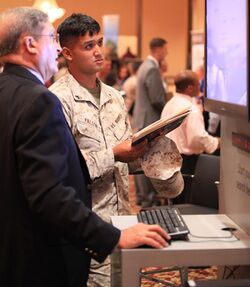
2013
FCC and broadband deployment
- In 2013, WIA submitted comments to the FCC that expressed support in speeding up broadband deployment. WIA helped Congress write legislation that funded broadband deployment. WIA had asked Congress to include infrastructure providers in the list of eligible recipients of federal broadband funding. WIA influenced members of the congressional committees that funded the $4.7 billion Broadband Technology Opportunities Program (BTOP) to make eligible wireless carriers, backhaul providers, and tower companies for funds.[21]
Warriors 4 Wireless
- In 2013, Cisco, American Tower, Dynis, and WIA created a program called Warriors 4 Wireless. The organization helps military veterans train and apply for jobs at wireless companies. The program's stated goal is to place 5,000 veterans in jobs by 2015. WIA has pledged money to the program.[22][23]
New headquarters
- WIA is headquartered at 500 Montgomery Street in Alexandria, Virginia. In 2013, WIA signed a 10-year lease on the 5,300 square foot office space.[24]
Advocacy
| For more information about trade associations, visit List of industry trade groups in the United States |
|---|
One of the main issues facing the wireless infrastructure industry is related to federal vs. local oversight of wireless infrastructure activity.
Federal vs. local oversight
In a February 2014 article in National Law Review, Washington telecommunications attorneys Dave Thomas and Douglas A. Svor explained the issue and the battle played out between the wireless industry and local governments.
In their article, Thomas and Svor state that spectrum and infrastructure serve as the most important aspects of federal communications laws in terms of being good for the economy and American competitiveness. For decades, the FCC has worked to make sure that critical communications infrastructure can get built with as little hassle as possible.
In April 2014, the FCC proposed to simplify the regulatory review process for wireless facilities. These facilities include DAS and small cells (see Small cells and HetNet Forum below for more information).
Small cells are built smaller than traditional cells that are typically fixed to larege wireless antenna towers. Infrastructure companies attach small cells to utility poles, street light poles, and even traffic lights. The wireless industry has supported the FCC's work in the areas mentioned above, while local governments have typically been opposed.
Thomas and Svor wrote:[25]
| “ | Industry's universal support for the FCC's proposals has been matched by local government's hostility towards them. State and local governments view the measures as an unwarranted - and unconstitutional - federal incursion into state and local authority. | ” |
List of major public policy issues for industry
| Issue | Image | Definition | Details | ||
|---|---|---|---|---|---|
| Broadband deployment | 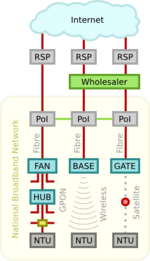
|
Broadband deployment is the process of getting permission to build, and then building the infrastructure for broadband
|
The U.S. private sector spends $73 billion each year to build broadband.[26] WIA wants the FCC to issue rulings known as "declaratory rulings". WIA asked the FCC to use declaratory rulings to reduce barriers that make it difficult for companies to build wireless infrastructure. For example, if a telecommunications company installs equipment on a structure or tower, WIA believes that other companies should be able to also install their equipment on that same structure or tower. WIA wants the FCC to declare that it would be discriminatory for a tower operator to not allow other companies to install their equipment on the structure or tower, in the example just mentioned.[27] | ||
| FCC "shot clock" rules | 
|
The FCC shot clock rules governs the length of time that local and state governments must process applications for certain cell towers. | If two or more wireless providers share a cell tower, the state/local agencies must process the applications within 90 days. The agencies must process applications within 150 days for new cell towers.[28] | ||
| Public safety | 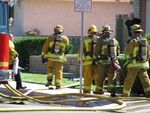
|
According to WIA, 70 percent of calls to 9-1-1 are made from wireless devices like cell phones and smart phones.[29] | WIA frames its advocacy work related to broadband deployment and speed in terms of public safety by arguing that "both citizens and public safety officials need access to wireless services anywhere and at all times."[29] The federal government, through its Broadband.gov website, says that investing in broadband will modernize public safety and homeland security communications. On the site, the government proposes a number of changes, including creating a nationwide public safety wireless communication network.[30] | ||
| Siting | 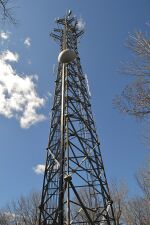
|
Building a new wireless tower or putting an antenna on an existing tower or building is called "siting."[31] |
WIA has submitted briefings to various governmental bodies to make it easier for cell tower companies to build new towers.[8][16] Construction of a new cell tower requires a number of approvals, including approval from state and local government authorities.[31] On May 5, 2014, the U.S. Supreme Court announced that it will hear a case involving cell tower siting. The main issue in the case—T-Mobile South v. Roswell, Ga.—is whether a city that denies a siting permit must justify that denial. The case stemmed from the city of Rosell, Georgia, which had denied a tower license to T-Mobile. When Roswell denied the license, it did not give an explanation to T-Mobile. WIA expressed its support of the Supreme Court making a decision on the issue.[32] Both WIA and the American Legislative Exchange Council (ALEC) have written suggested legislation for states to adopt to regulate tower siting.[lower-alpha 3] | ||
| Small cells | 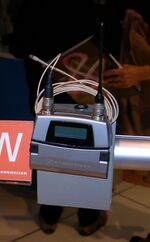
|
A small cell is a piece of equipment used for radio transmission that is typically low-powered. Wireless providers use small cells to improve the coverage of cell phones in small areas like buildings, homes, and neighborhoods.[33] | For WIA and its members, the main federal government issue regarding small cells is environmental. When companies build small cells, the federal government requires a review process. The process reviews the historical and environmental impact of the building. The wireless infrastructure industry wants the government to exclude small cells from that review process. The industry believes that small cells, due to their size, typically do not pose any significant issues that would warrant an historical or environmental review.[34]
| ||
| Utility pole attachment | 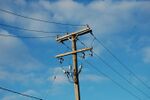
|
A utility pole is a pole, often made of wood or durable metals, that holds power lines and cables overhead.[35] Around 134 million poles exist in the U.S. The federal government controls use of some poles, while states control use of others.[36] | Entities that build and own the utility poles have had partnerships with companies that use utility poles. The partnership has existed since the early 1900s and is referred to as "joint use." The company that rents space on the pole is often referred to as the attacher.[37] Section 224 of the Communications Act allows telecommunications companies to use utility poles. The law requires utility pole owners (usually utility companies) to charge reasonable rates for access to the poles. Section 703 of the 1996 Communications Act extended use of utility poles, and the provisions for reasonable rates, to wireless providers.[38]
WIA wants wireless infrastructure developers to be able to use (have access to) utility poles. The industry believes that because the poles already exist, infrastructure developers should use the poles when building new networks. The industry wants the FCC to make sure that regulations make it easier and more cost-effective for wireless infrastructure developers to use utility poles.[39] |
HetNet Forum
HetNets, short for "Heterogeneous Networks", are a combination of technologies that make quality wireless broadband possible.[40] According to international communications company Ericsson, heterogeneous networks help wireless customers enjoy activities that require a large amount of data, such as watching streaming videos, uploading photos and using cloud storage services. HetNets use both radio and cellular technologies.[41]
To advocate for deployment of HetNet, WIA runs a membership forum called the HetNet Forum. The purpose of the forum is to advance the development of heterogeneous networks in the United States, as well as to push policies related to distributed antenna systems (DAS),[lower-alpha 4] small cells, and fiber backhaul.[lower-alpha 5][44] Several major U.S. wireless carriers, such as AT&T, Sprint, T-Mobile and Verizon Wireless, serve as governing members of the forum.[40]
Prior to April 2013, the HetNet Forum had been called the DAS Forum. WIA changed the name to accommodate a growing membership that represented a more diverse group of technologies. Instead of running a forum focusing only on DAS, WIA expanded the forum to focus on several technologies such as microcells, picocells, Wi-Fi and remote radio units, in addition to DAS. As of April 2013, about 60 companies participated as members in the HetNet Forum.[45]
Other trade associations, such as the Small Cell Forum, have competed with WIA for members from the small cell industry.[46]
Criticism
In 2014, Senator Al Franken criticized the "revolving door" hiring placement of former FCC commissioners. Specifically, Franken criticized the hiring of FCC Commissioner Meredith Baker by Comcast. Franken did not mention WIA in his remarks, but an OpenSecrets.org article covering the remarks mentioned the hiring of former Commissioner Jonathan Adelstein by WIA.[47]
Dictionaries and encyclopedias
 "Wireless Telegraphy and Telephony". Collier's New Encyclopedia. 1921.
"Wireless Telegraphy and Telephony". Collier's New Encyclopedia. 1921.- Tower and Antenna Siting at FCC Encyclopedia
- Broadband Acceleration at FCC Encyclopedia
- Broadband and Internet in the Consumer Publications Library at the U.S. Federal Communications Commission (FCC)
Government documents
- Wireless Telecommunications Bureau at the Federal Communications Commission (FCC)* Understanding Wireless Communications in Public Safety at FCC
- 16th Mobile Wireless Competition Report at FCC
- National Broadband Map, a tool published by the FCC, allows citizens to enter any address to view wired and wireless broadband services available.
- Public Safety Wireless Technology Links at the National Institute of Standards and Technology (NIST)
Literature
News
- Wireless communications selected news and commentary at The New York Times
- Wireless infrastructure selected news and commentary at Fierce Wireless
- Wireless carriers collected news and videos at Fox Business
Technical guides
- This HetNet visual aide by Ericsson shows how various components, such as Wi-Fi, base stations, and wireless transmitters work together to form a Heterogeneous Network (HetNet).
- Pole Attachments at National Association of Regulatory Utility Commissioners (NARUC)
Video
- Jonathan Adelstein Appearances on C-SPAN
- Announcing the National Broadband Plan video by Julius Genachowski, Chairman of the U.S. Federal Communications Commission, at broadband.gov
WIA website links
- 2014 Wireless Infrastructure Show
- Wireless Broadband Infrastructure: A Catalyst for GDP and Job Growth 2013-2017 report published by WIA (September 2013)
Website directories
Gallery
See also
- National Telecommunications and Information Administration
- Federal Communications Act
- Federal Communications Commission (FCC)
- First Responder Network Authority (FirstNet)
- HetNet
- Policies promoting wireless broadband in the United States
Notes
- ↑ Mr. Adelstein's comments are noteworthy when viewed in the context of President Obama's wireless connectivity goal. In the same month, the White House released documentation that said that President Obama had set a goal of connecting 99 percent of American students to high-speed broadband and wireless by the year 2019[13]
- ↑ Collocation is simply the act of placing something next to something else.[17]
- ↑ The PCIA model legislation can be found at Model State Wireless Telecommunications Facility Siting Legislation. The ALEC model bill can be found at Wireless Communications Tower Siting Act.
- ↑ A distributed antenna system, referred to as a DAS, is a network of small antennas installed throughout a building. The antennas serve as repeaters for wireless signals. A DAS is often used to improve poor wireless coverage inside large buildings.[42]
- ↑ Backhauling is the practice of sending data over a network in an "out of the way route" in order to get the data to its destination quicker or more cheaply. Backhauling can also refer to the practice of getting data to a point from which it can then be distributed to its intended targets. This latter definition often applies to satellite TV systems.[43]
External links
References
- ↑ "WIA – Wireless Infrastructure Association". http://www.wia.org.
- ↑ Kamen, Al (18 September 2012). "Mitt Romney's Latino problem". The Washington Post. https://www.washingtonpost.com/politics/decision2012/mitt-romneys-latino-problem/2012/09/17/bc506a68-00f5-11e2-b257-e1c2b3548a4a_story.html. Retrieved 13 May 2014.
- ↑ 3.0 3.1 Kamen, Al (14 September 2012). "Adelstein to head PCIA, the wireless infrastructure trade association". The Washington Post. https://www.washingtonpost.com/blogs/in-the-loop/post/adelstein-to-head-pcia-the-wireless-infrastructure-trade-association/2012/09/14/73ea342e-fe85-11e1-b153-218509a954e1_blog.html. Retrieved 5 May 2014.
- ↑ "About PCIA". http://www.pcia.com/about. Retrieved 5 May 2014.
- ↑ "Comments of PCIA - The Wireless Infrastructure Association and the HetNet Forum; Before the Federal Communications Commission; In the Matter of Modernizing the E-rate Program for Schools and Libraries". 21 April 2014. http://apps.fcc.gov/ecfs/document/view?id=7521098977. Retrieved 5 May 2014. "PCIA’s members develop, own, manage, and operate towers, rooftop wireless sites, and other facilities for the provision of all types of wireless, telecommunications, and broadcasting services."
- ↑ "Comments of American Tower Corporation; Before the DEPARTMENT OF COMMERCE; In the Matter of Development of the State and Local Implementation Grant Program for the Nationwide Public Safety Broadband Network ( Docket No. 120509050-1050-01)" (PDF). Washington, D.C.: National Telecommunications & Information Administration. 15 June 2012. http://www.ntia.doc.gov/files/ntia/american_tower_ntia_rfi_comments_final.pdf. Retrieved 5 May 2014. "American Tower is also a member of PCIA – The Wireless Infrastructure Association and the DAS Forum (collectively referred to herein as “PCIA”), who is also filing comments in this proceeding. American Tower supports PCIA’s comments."
- ↑ "PCIA Member News". http://www.pcia.com/pcia-member-news. Retrieved 5 May 2014.
- ↑ 8.0 8.1 8.2 "Brief for PCIA-The Wireless Infrastructure Association As Amicus Curiae In Support of Respondents" (PDF). American Bar Association. 26 December 2012. http://www.americanbar.org/content/dam/aba/publications/supreme_court_preview/briefs-v2/11-1545-11-1547_resp_amcu_pcia.authcheckdam.pdf. Retrieved 5 May 2014.
- ↑ "Advocacy Issues". http://www.pcia.com/advocacy/issues. Retrieved 5 May 2014.
- ↑ "What is the Wireless Infrastructure Show?". PCIA - The Wireless Infrastructure Association. http://www.wirelessinfrastructureshow.com/about-us. Retrieved 5 May 2014.
- ↑ "Board of Directors". https://wia.org/?s=board. Retrieved 5 May 2014.
- ↑ "Jonathan S. Adelstein". 2013. http://www.pcia.com/2013-02-01-19-59-17/staff. Retrieved 5 May 2014.
- ↑ "FACT SHEET: Opportunity For All – Answering the President’s Call to Enrich American Education Through ConnectED". The White House Briefing Room. The White House, President Barack Obama. 4 February 2014. http://www.whitehouse.gov/the-press-office/2014/02/04/fact-sheet-opportunity-all-answering-president-s-call-enrich-american-ed. Retrieved 5 May 2014.
- ↑ "Wireless Infrastructure". 18 February 2014. http://www.c-span.org/video/?317864-1/communicators-jonathan-adelstein. Retrieved 5 May 2014.
- ↑ "Tim House". PCIA - The Wireless Infrastructure Association. http://www.pcia.com/2013-02-01-19-59-17/staff. Retrieved 13 May 2014.
- ↑ 16.0 16.1 "PCIA's Frequency Coordination Services - Leading the Industry". http://www.pcia.com/index.php?option=com_content&view=article&id=32&Itemid=10. Retrieved 5 May 2014.
- ↑ "Collocate". Online dictionary. Merriam-Webster. http://www.merriam-webster.com/dictionary/collocate. Retrieved 13 May 2014.
- ↑ "Local Review of Collocation Applications, Interpretive Guidance". Federal Communications Commission. 25 January 2013. http://www.fcc.gov/document/local-review-collocation-applications-interpretive-guidance. Retrieved 13 May 2014.
- ↑ "Is Federal Collocation By Right Unconstitutional?". Ashburn, Virginia: AGL Media Group. http://www.aglmediagroup.com/muni-attorney-questions-constitutionality-of-collocation-by-right/. Retrieved 13 May 2014.
- ↑ Ryan, Laura (20 November 2013). "Wheeler Offers Support for New Warriors 4 Wireless Initiative". The National Journal.
- ↑ Stimulus: The Importance of Wireless Infrastructure to Ubiquitous Broadband. Information Gatekeepers Inc. GGKEY:F6ZAYBUPZ2F. https://books.google.com/books?id=On9kUdZ4WhwC.
- ↑ "PCIA Proudly Supports Launch of Warriors 4 Wireless to Help Returning Veterans Find Work in Wireless Industry" (Press release). PCIA - The Wireless Infrastructure Association. 20 November 2013. Retrieved 5 May 2014.
- ↑ "The White House and "Warriors 4 Wireless" Partners Announce New Commitment to Connect Veterans to High-Tech Jobs" (PDF) (Press release). Washington, D.C.: The White House, President Barack Obama. 20 November 2013. Retrieved 5 May 2014.
- ↑ "Silverwood and Freedom Development buy apartment building for $33M". The Washington Post. Nexis. 29 April 2013.
- ↑ Thomas, Dave; Svor, Douglas A. (28 February 2014). "Sleeper 'Small' Cells: The Battle Over The FCC's Wireless Infrastructure Proceeding - Federal Communications Commission". National Law Review (National Law Forum, LLC). ISSN 2161-3362.
- ↑ "Broadband Industry Stats; The Story Behind the Statistics". United States Telecom Association. http://www.ustelecom.org/broadband-industry/broadband-industry-stats. Retrieved 13 May 2014.
- ↑ "Removing Barriers to Wireless Infrastructure Deployment" (PDF). Presentation to the Federal Communications Commission Technical Advisory Committee. PCIA – The Wireless Infrastructure Association. 19 May 2011. http://www.pcia.com/images/Advocacy_Docs/tac_barriers_to_deployment_presentation.pdf. Retrieved 13 May 2014.
- ↑ Donovan, Fred (27 January 2013). "FCC modifies rules for local review of cell tower modifications". FierceMobileIT (Washington, D.C.: FierceMarkets, a division of Questex Media Group LLC). http://www.fiercemobileit.com/story/fcc-modifies-rules-local-review-cell-tower-modifications/2013-01-27. Retrieved 5 May 2014.
- ↑ 29.0 29.1 "Public Safety". PCIA - The Wireless Infrastructure Association. http://pcia.com/advocacy-sp-406566135/issues/937-advocacy/advocacy-issues/496-public-safety. Retrieved 13 May 2014.
- ↑ "National Broadband Plan by Issues: Public Safety and Homeland Security". Federal Communications Commission. http://www.broadband.gov/issues/public-safety.html. Retrieved 13 May 2014.
- ↑ 31.0 31.1 "Tower and Antenna Siting". Federal Communications Commission (FCC). http://www.fcc.gov/encyclopedia/tower-and-antenna-siting. Retrieved 5 May 2014.
- ↑ Eggerton, John (5 May 2014). "Supremes To Weigh In On Cell Tower Citing Issue". Broadcasting & Cable (Los Angeles, California: NewBay Media, LLC). http://www.broadcastingcable.com/news/washington/supremes-weigh-cell-tower-citing-issue/130908.
- ↑ "What is a small cell?". Small Cell Forum. United Kingdom: Small Cell Forum Ltd.. http://www.smallcellforum.org/aboutsmallcells-small-cells-what-is-a-small-cell. Retrieved 13 May 2014.
- ↑ Hill, Kelly (6 February 2014). "PCIA, HetNet Forum ask FCC to streamline small cell rules". RCR Wireless News. http://www.rcrwireless.com/article/20140206/fcc_wireless_regulations/pcia-hetnet-forum-ask-fcc-to-streamline-small-cell-rules/. Retrieved 13 May 2014.
- ↑ "What Is a Utility Pole?". wise GEEK. Sparks, Nevada: Conjecture Corporation. http://www.wisegeek.com/what-is-a-utility-pole.htm. Retrieved 13 May 2014.
- ↑ "USTelecom Fact Sheet On Pole Attachments". United States Telecom Association. 2011. http://www.ustelecom.org/blog/ustelecom-fact-sheet-pole-attachments. Retrieved 13 May 2014.
- ↑ Little, Ashley (7 January 2014). "Supreme Court Ruling On FCC Joint Use Utility Pole Rules". The Alden Updater. Birmingham, Alabama: Alden Systems, Inc.. http://info.aldensys.com/blog/bid/331014/Supreme-Court-Ruling-On-FCC-Joint-Use-Utility-Pole-Rules. Retrieved 13 May 2014.
- ↑ (PDF) Pole Attachments (Report). 2001 NARUC Summer Meetings in Seattle, Washington: Ad Hoc Group of the 706 Federal/State Joint Conference on Advanced Services. July 2001. pp. 1–2. http://www.naruc.org/Publications/poleattachment_summer01.pdf. Retrieved 13 May 2014.
- ↑ "Utility Pole Attachment and Right-of-Way Regulation". PCIA - The Wireless Infrastructure Association. http://www.pcia.com/advocacy/issues/229-fcc-pole-attachment-regulation. Retrieved 13 May 2014.
- ↑ 40.0 40.1 "About Us: Who We Are". PCIA - The Wireless Infrastructure Association. http://www.thedasforum.org/about-us/who-we-are/. Retrieved 5 May 2014. "The HetNet Forum is a broad-based organization dedicated to the development of the Heterogeneous Network (HetNet), a combination of technologies that enable wireless broadband."
- ↑ "Heterogeneous Network (Hetnet): Servicing data hungry smartphones". Ericsson. http://www.ericsson.com/res/thecompany/docs/press/media_kits/hetnet_infographic_vertical_04.pdf. Retrieved 13 May 2014.
- ↑ "Definition: distributed antenna system (DAS)". Search Mobile Computing. Newton, Massachusetts: TechTarget. http://searchmobilecomputing.techtarget.com/definition/distributed-antenna-system-DAS.
- ↑ "Definition: backhaul". WhatIs.com. Newton, Massachusetts: TechTarget. http://whatis.techtarget.com/definition/backhaul. Retrieved 13 May 2014.
- ↑ "HetNet Forum to moderate roundtable on DAS, small cells at TIA event". PCIA – The Wireless Infrastructure Association. 7 May 2014. http://www.thedasforum.org/hetnet-forum-to-moderate-roundtable-on-das-small-cells-at-tia-event/. Retrieved 13 May 2014.
- ↑ "The DAS Forum Renamed HetNet Forum" (Press release). Alexandria, Virginia: PCIA - The Wireless Infrastructure Association. PR Newswire. 22 April 2013. Retrieved 13 May 2014.
- ↑ Meyer, Dan (22 April 2013). "DAS Forum spreads focus, now HetNet Forum". RCR Wireless News. http://www.rcrwireless.com/article/20130422/associations/das-forum-spreads-focus-now-hetnet-forum/. Retrieved 13 May 2014.
- ↑ Feinberg, Robbie (18 April 2014). "The Comcast-FCC Revolving Door". OpenSecrets.org (Washington, D.C.: Center for Responsive Politics). http://www.opensecrets.org/news/2014/04/the-comcast-fcc-revolving-door.html. Retrieved 5 May 2014.
